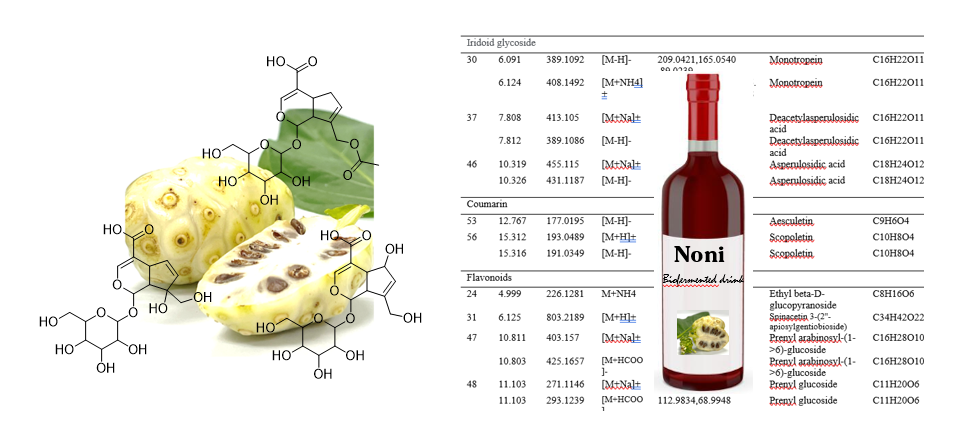Antioxidant Activity and Chemical Constituents Identification by LC-MS/MS in Bio-fermented Fruit Drink of Morinda citrifolia L.
DOI:
https://doi.org/10.48048/tis.2023.6498Keywords:
Morinda citrifolia L., Antioxidant activity, Chemical constituents, LC-MS/MS, Bio-fermented drinkAbstract
Noni bio-fermented drink is a fermented fruit of Morinda citrifolia L. Noni fruit is reported to be useful for a wide range of maladies, and consumers throughout the world perceive similar benefits. However, the existing evidence does have some limitations as far as its general application to noni fruit products. This study is intended to assess the quality of noni bio-fermented drink. The fruit was fermented using wild environmental yeast by a local entrepreneur. After 3 months, the mixture was filtered, sweetened, pasteurized, and bottled. The finish product was investigated for its antioxidant activity, total phenolic content and phytochemical constituents. Antioxidant activities exhibited profound results in term of 2,2-diphenyl-1-picryhydrazyl (DPPH) assay with an IC50 value of 14.94±0.76 μg/mL which was very close to that of Trolox at 8.47±0.16 μg/mL. The low phenolic content of 0.75±0.01 mg gallic acid equivalent (GAE)/g measured by Folin-Ciocalteu reagent method. The data of mass spectra and their fragmentations from LC-MS/MS identified 53 of 59 phytochemical compounds from the drink. Iridoid glucosides; asperulosidic acid, deacetylasperulosidic acid and monotropein as well as coumarin; aesculetin, scopoletin were identified as markers of this drink. Moreover, amino acids including organic acids, sugars and sugar in glycosidic forms were elucidated. Sulfur compounds in this drink namely 2-Sulfanylpropan-1-ol; 3-sulfanylpropan-1-ol, thiodiglycol and L-Methionine were identified as the possible cause of the pungent characteristic fragrance. As a result, noni fruit bio fermented drink encompasses numerous nutrients and biological compounds with potent antioxidant activity which could be stated as wellness drink for health merit.
HIGHLIGHTS
- Chemical profiles of Thai noni fruit bio-fermented drink was established
- Noni drink contains numerous phytonutrients and bioactive compounds
- Flavonoids and Iridoid glycosides can be identified and selected as markers for quality control
- LC-MS/MS is a powerful technique for identification of compounds
- U2T program for product development
GRAPHICAL ABSTRACT
Downloads
Metrics
References
European Commission. Commission decision of 5 June 2003 authorising the placing on the market of “noni juice” (juice of the fruit of Morinda citrifolia L.) as a novel food ingredient under regulation (EC) No 258/97 of the European parliament and of the council. Official Journal of the European Union, 2003.
China Food and Drug Administration. Health food record information release. China Food and Drug Administration, Beijing, China, 2011.
D Lee, JS Yu, P Huang, M Qader, A Manavalan, X Wu, JC Kim, C Pang, S Cao, KS Kang and KH Kim. Identification of anti-inflammatory compounds from Hawaiian Noni (Morinda citrifolia L.) fruit juice. Molecules 2020; 25, 4968.
BN Su, AD Pawlus, HA Jung, WJ Keller, JL McLaughlin and AD Kinghorn. Chemical constituents of the fruits of Morinda citrifolia (Noni) and their antioxidant activity. J. Nat. Prod. 2005; 68, 592-5.
G Liu, A Bode, WY Ma, S Sang, CT Ho and Z Dong. Two novel glycosides from the fruits of Morinda citrifolia (noni) inhibit AP-1 transactivation and cell transformation in the mouse epidermal JB6 cell line. Cancer Res. 2001; 61, 5749-56.
S Deng, BJ West and CJ Jensen. A quantitative comparison of phytochemical components in global noni fruits and their commercial products. Food Chem. 2010; 122, 267-70.
UJ Youn and LC Chang. Chemical constituents of fermented noni (Morinda citrifolia) juice exudates and their biological activity. Nat. Prod. Sci. 2017; 23, 16-20.
O Potterat and M Hamburger. Morinda citrifolia (Noni) fruit-phytochemistry, pharmacology, safety. Planta Med. 2007; 73, 191-9.
R Abou Assi, Y Darwis, IM Abdulbaqi, AA khan, L Vuanghao and MH Laghari. Morinda citrifolia (Noni): A comprehensive review on its industrial uses, pharmacological activities, and clinical trials. Arab. J. Chem. 2017; 10, 691-707.
BJ West, S Deng, F Isami, A Uwaya and CJ Jensen. The potential health benefits of noni juice: A review of human intervention studies. Foods 2018; 7, 58.
T Margraf, AR Karnopp, ND Rosso and D Granato. Comparison between folin-ciocalteu and prussian blue assays to estimate the total phenolic content of juices and teas using 96-well microplates. J. Food Sci. 2015; 80, C2397-C2403.
M Irshad, M Zafaryab, M Singh and MM Rizvi. Comparative analysis of the antioxidant activity of Cassia fistula extracts. Int. J. Med. Chem. 2012; 2012, 157125.
VV Mossine and TP Mawhinney. 1-Amino-1-deoxy-D-fructose (“fructosamine”) and its derivatives. Adv. Carbohydr. Chem. Biochem. 2010; 64, 291-402.
DL Ma, M Chen, CX Su and BJ West. In vivo antioxidant activity of deacetylasperulosidic acid in noni. J. Anal. Meth. Chem. 2013; 2013, 804504.
L Pruccoli, F Morroni, G Sita, P Hrelia and A Tarozzi. Esculetin as a bifunctional antioxidant prevents and counteracts the oxidative stress and neuronal death induced by amyloid protein in SH-SY5Y cells. Antioxidants 2020; 9, 551.
F Alali, T El-Elimat, H Albataineh, Q Al-Balas, M Al-Gharaibeh, JO Falkinham, WL Chen, SM Swanson and NH Oberlies. Cytotoxic Homoisoflavones from the bulbs of Bellevalia eigii. J. Nat. Prod. 2015; 78, 1708-15.
H Fiege, HW Voges, T Hamamoto, S Umemura, T Iwata, H Miki, Y Fujita, HJ Buysch, D Garbe and W Paulus. Ullmann’s encyclopedia of industrial chemistry. Wiley‐VCH, Weinheim, Germany, 2000.
N Ngamdokmai, K Ingkaninan, CN Scholfield, K Insumrong, N Neungchamnong, G Minale and S Warinhomhoun. A Thai traditional triple-fruit formulation “Phikud Tri-Phon” may provide fat loss and nutritional benefits. Foods 2022; 11, 3067.

Downloads
Published
How to Cite
Issue
Section
License
Copyright (c) 2023 Walailak University

This work is licensed under a Creative Commons Attribution-NonCommercial-NoDerivatives 4.0 International License.






